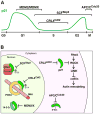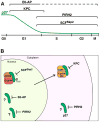Multiple degradation pathways regulate versatile CIP/KIP CDK inhibitors
- PMID: 22154077
- PMCID: PMC3298816
- DOI: 10.1016/j.tcb.2011.10.004
Multiple degradation pathways regulate versatile CIP/KIP CDK inhibitors
Abstract
The mammalian CIP/KIP family of cyclin-dependent kinase (CDK) inhibitors (CKIs) comprises three proteins--p21(Cip1/WAF1), p27(Kip1), and p57(Kip2)--that bind and inhibit cyclin-CDK complexes, which are key regulators of the cell cycle. CIP/KIP CKIs have additional independent functions in regulating transcription, apoptosis and actin cytoskeletal dynamics. These divergent functions are performed in distinct cellular compartments and contribute to the seemingly contradictory observation that the CKIs can both suppress and promote cancer. Multiple ubiquitin ligases (E3s) direct the proteasome-mediated degradation of p21, p27 and p57. This review analyzes recent data highlighting our current understanding of how distinct E3 pathways regulate subpopulations of the CKIs to control their diverse functions.
Copyright © 2011 Elsevier Ltd. All rights reserved.
Figures


 is an inhibitory symbol, and an arrow is an activating symbol. See text for details.
is an inhibitory symbol, and an arrow is an activating symbol. See text for details.

Similar articles
-
Cortactin modulates RhoA activation and expression of Cip/Kip cyclin-dependent kinase inhibitors to promote cell cycle progression in 11q13-amplified head and neck squamous cell carcinoma cells.Mol Cell Biol. 2010 Nov;30(21):5057-70. doi: 10.1128/MCB.00249-10. Epub 2010 Aug 30. Mol Cell Biol. 2010. PMID: 20805359 Free PMC article.
-
Ubiquitylation and proteasomal degradation of the p21(Cip1), p27(Kip1) and p57(Kip2) CDK inhibitors.Cell Cycle. 2010 Jun 15;9(12):2342-52. doi: 10.4161/cc.9.12.11988. Epub 2010 Jun 15. Cell Cycle. 2010. PMID: 20519948 Free PMC article. Review.
-
Genetic characterization of the role of the Cip/Kip family of proteins as cyclin-dependent kinase inhibitors and assembly factors.Mol Cell Biol. 2014 Apr;34(8):1452-9. doi: 10.1128/MCB.01163-13. Epub 2014 Feb 10. Mol Cell Biol. 2014. PMID: 24515438 Free PMC article.
-
CDK inhibitors, p21(Cip1) and p27(Kip1), participate in cell cycle exit of mammalian cardiomyocytes.Biochem Biophys Res Commun. 2014 Jan 17;443(3):1105-9. doi: 10.1016/j.bbrc.2013.12.109. Epub 2013 Dec 28. Biochem Biophys Res Commun. 2014. PMID: 24380855
-
The multiple roles of the cyclin-dependent kinase inhibitory protein p57(KIP2) in cerebral cortical neurogenesis.Dev Neurobiol. 2012 Jun;72(6):821-42. doi: 10.1002/dneu.20999. Dev Neurobiol. 2012. PMID: 22076965 Review.
Cited by
-
Patterns of Early p21 Dynamics Determine Proliferation-Senescence Cell Fate after Chemotherapy.Cell. 2019 Jul 11;178(2):361-373.e12. doi: 10.1016/j.cell.2019.05.041. Epub 2019 Jun 13. Cell. 2019. PMID: 31204100 Free PMC article.
-
ATM regulates Cdt1 stability during the unperturbed S phase to prevent re-replication.Cell Cycle. 2014;13(3):471-81. doi: 10.4161/cc.27274. Epub 2013 Nov 26. Cell Cycle. 2014. PMID: 24280901 Free PMC article.
-
Candidate oncogene circularNOP10 mediates gastric cancer progression by regulating miR-204/SIRT1 pathway.J Gastrointest Oncol. 2021 Aug;12(4):1428-1443. doi: 10.21037/jgo-21-422. J Gastrointest Oncol. 2021. PMID: 34532100 Free PMC article.
-
Enzyme-independent role of EZH2 in regulating cell cycle progression via the SKP2-KIP/CIP pathway.Sci Rep. 2024 Jun 11;14(1):13389. doi: 10.1038/s41598-024-64338-4. Sci Rep. 2024. PMID: 38862595 Free PMC article.
-
MAPK signaling pathway regulates p27 phosphorylation at threonin 187 as part of the mechanism triggered by early-weaning to induce cell proliferation in rat gastric mucosa.PLoS One. 2013 Jun 7;8(6):e66651. doi: 10.1371/journal.pone.0066651. Print 2013. PLoS One. 2013. PMID: 23762493 Free PMC article.
References
-
- Murray AW. Recycling the cell cycle: cyclins revisited. Cell. 2004;116:221–234. - PubMed
-
- Besson A, et al. CDK inhibitors: cell cycle regulators and beyond. Dev Cell. 2008;14:159–169. - PubMed
-
- Glickman MH, Ciechanover A. The ubiquitin-proteasome proteolytic pathway: destruction for the sake of construction. Physiol Rev. 2002;82:373–428. - PubMed
-
- Sherr CJ, Roberts JM. CDK inhibitors: positive and negative regulators of G1-phase progression. Genes Dev. 1999;13:1501–1512. - PubMed
Publication types
MeSH terms
Substances
Grants and funding
LinkOut - more resources
Full Text Sources
Miscellaneous

